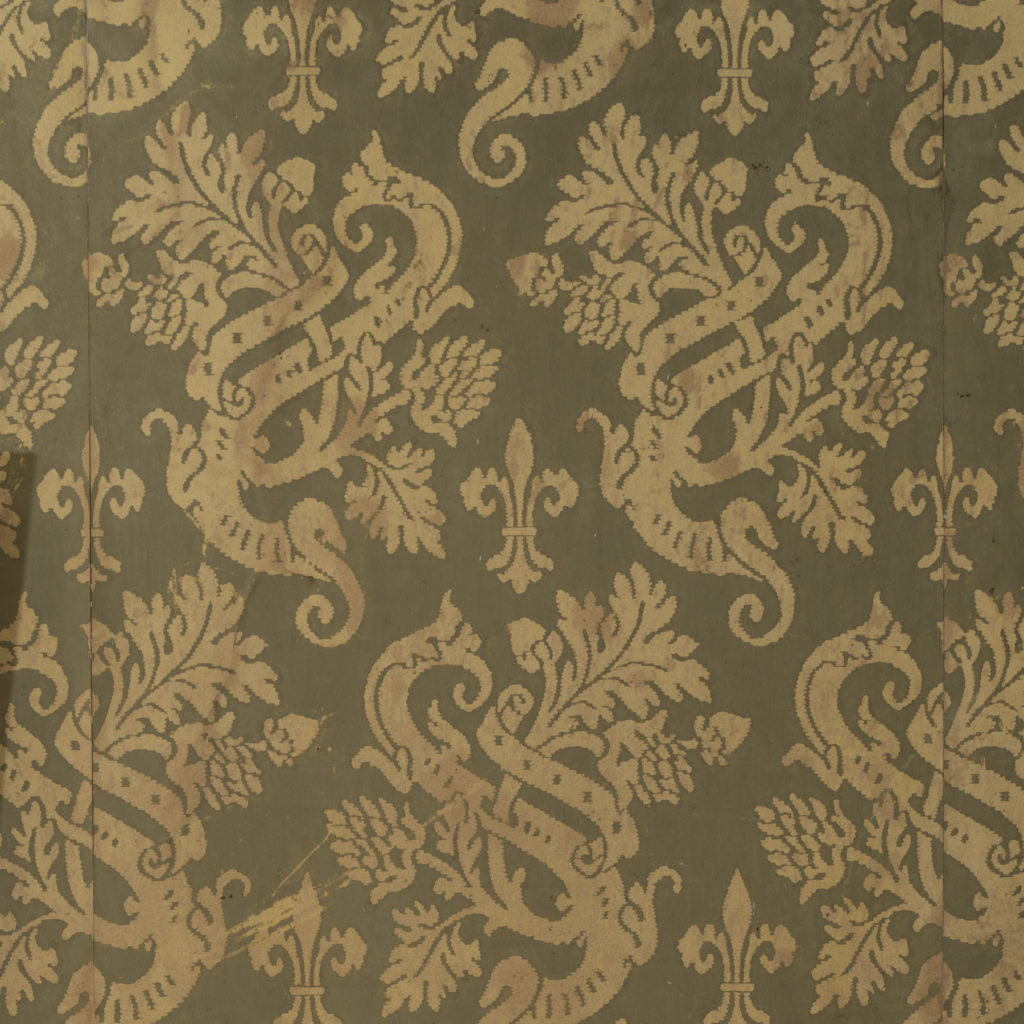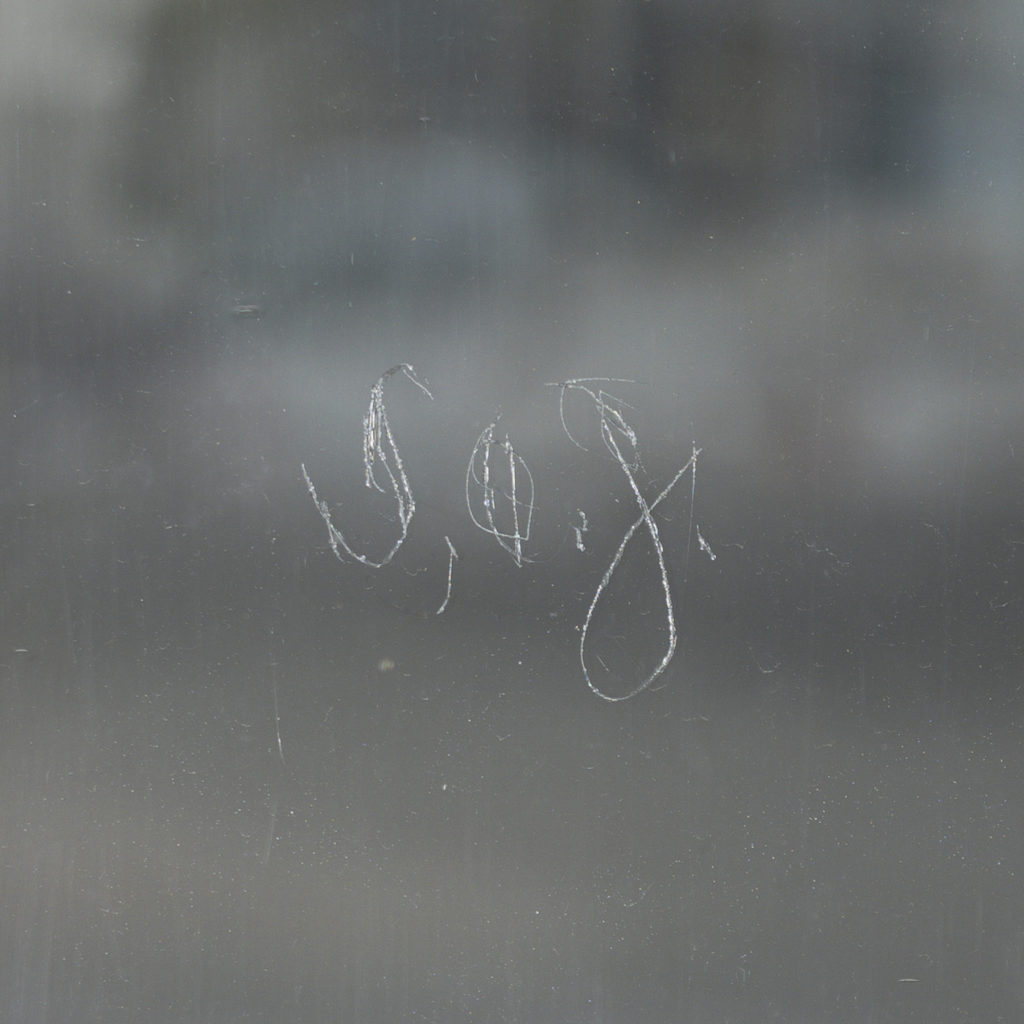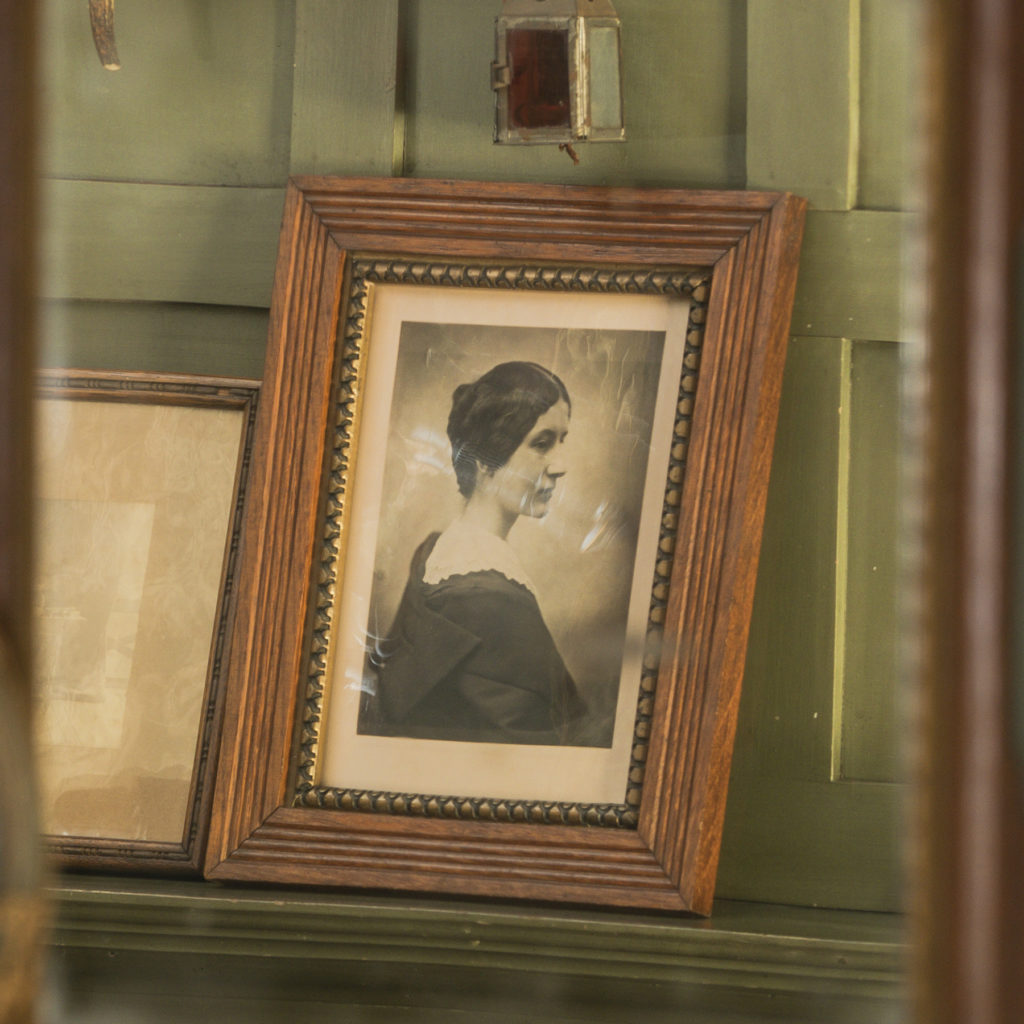 Sarah Orne Jewett House
Sarah Orne Jewett House
Sarah's Room

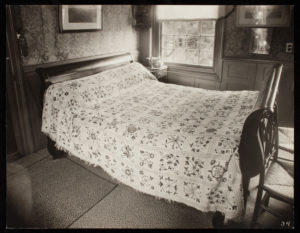 Sarah Orne Jewett’s room remains essentially unchanged since her death in 1909.
Sarah Orne Jewett’s room remains essentially unchanged since her death in 1909.
Jewett filled the room with both functional items and those that held deep meaning for her.
Wallpaper
Sarah’s Room Wallpaper
The block-printed wallpaper in Sarah’s room was made in France or the United States between 1885-1890 and is one that Sarah and Mary had installed around the time they moved into the house. The design of leaves, scrolls, and fleurs-de-lis was printed on a textured paper to give the effect of a textile. The decorative pattern is actually the ground color of the paper with the darker olive printed on top.
Etched in Glass
S.O.J.
In Sarah’s day, it was not an unheard-of gesture to etch one’s name in a one’s own house window. There is a long royal tradition of scratching messages in glass, allegedly dating back to Queen Elizabeth I. Scratching one’s name in a window was akin to a kind of deeply felt signing of a guest book, so that one’s presence at a place would not be forgotten.
That Sarah Orne Jewett scratched her monogram into the glass window of her bedroom speaks to how she cherished her home.
The etching itself speaks to how fond Jewett was of her monogram. Sarah Orne Jewett had an awareness about her identity, about what she wanted to do with her life and how she wanted to live. Her monogram seems to have symbolized that identity to her. Generally, in signing a letter to an acquaintance, she would write “Sarah Orne Jewett, or Sarah O. Jewett.” To her close circle of friends, she signed “S.O.J.”
An Intensely Personal Space
Sarah’s Mantel
Sarah Orne Jewett’s bedroom was an intensely personal space—the mantel arranged with carefully chosen objects that held deep meaning to her.
Riding Crop (and Carriage Lantern)
Sarah Orne Jewett loved her horses and she loved riding, particularly the horse Sheila, of whom she wrote, “; I glory in her good spirits and I think she has a right to be proud and willful if she chooses.” (“October Ride,” 1881)
Communion Cup
Sarah Orne Jewett was Christian. Raised in the Congregational Church, as a young adult, she converted to the Episcopal faith of her ancestral heritage.
Child's Mug
Dating from about 1800-1810, this children’s pearlware mug with the lettering, “A Trifle Shews Respect,” could have been handed down in the family or purchased as an antique. Jewett had a childlike side to her personality and remarked to friend Sara Norton on her forty-eighth birthday, “Today is my birthday, and I am always 9 years old.”
Portrait of Annie Fields
Taken as a young woman. The love of Jewett’s life, Annie Fields most often stayed at her home in Boston or Manchester while Sarah was in South Berwick, and Sarah wrote often of missing her. Because of two mirrors strategically placed, the portrait can be seen from any angle in the room.
Landscape at Cortina
A scene from Italy’s Dolomite Mountains by Sarah Wyman Whitman, a dear friend of Sarah Orne Jewett and Annie Fields. Wyman was an accomplished artist who designed nearly all of Jewett’s book covers. She also created the stained-glass iris in the home’s stair landing, as a gift to Jewett.
Silhouette, Theodore H. Jewett
This silhouette of Sarah’s father was taken when he was sixteen (in 1831) and at Bowdoin College. Sarah shared a close relationship with her father. Seventy years later, Jewett was the first woman to be awarded an honorary Doctor of Letters degree at Bowdoin.
Hearth Tiles
Delft earthenware, these hearth tiles, evoking those in the library, date to 1830-1840.
Sampler
A sampler by Martha Pratt, dated 1800, may have appealed to Jewett’s love of childhood.
to learn more
Sarah’s Chest of Drawers
The chest and looking glass, both made in the late eighteenth or very early nineteenth century, suggest the world of accumulated family furnishings around which Sarah and Mary grew up. These would have provided tangible links to the generations of Jewetts, Ornes, Perrys, and Gilmans who proceeded them.
Eyeglasses
In later years, images of Jewett show her with eyeglasses, worn around her neck.
Owl
One of Sarah’s nicknames, given to her by close friend, artist Celia Thaxter, was Owl. Celia Thaxter’s nickname was Sandpiper.
Three Stuffed Toy Dogs
Dating from the time when or shortly after Sarah and Mary inherited the house. The Jewett family had a number of dogs, and Sarah had an affinity for them, from Joe, a childhood dog, to Jock, Crabby, and Roger, an Irish Setter she had with Annie Fields and seemed to especially dote on. Roger spent winters in Boston with Sarah and Annie.
Photograph, Jessie Cochrane
Jessie Cochrane was a gifted pianist who studied in Europe with Franz Liszt whom Annie Fields mentored. She was part of the Boston Coterie of artists who gathered often on Saturday afternoons at Fields’ Charles Street home in Boston.
Wallpaper
Dating to 1880-90, the paper would have been installed by Sarah Orne Jewett for her new room after inheriting her grandfather’s house. The paper is a fleur de lis design. The olive-green color was a popular hue in the Arts and Crafts Movement style.
Mirror
From this mirror, and a second placed in the room, Annie Fields' portrait on the mantel is reflected so that it can be seen at any vantage point in the room.
to learn more
Sarah’s Bedside
Sarah Orne Jewett led an extraordinarily active life, despite a lifetime of suffering with rheumatoid arthritis. But there were times when her health required periods of rest and her bedroom provided a much needed sanctuary.
While Sarah was recuperating in bed, a bell pull, and later a buzzer, enabled her to call Katy or Mary Galvin when she needed something.
The mirror behind Sarah’s bed was strategically placed in a way that reflected the photograph of Annie on the opposite wall.
Without question the most influential person in Sarah’s childhood was her father who encouraged her love of the natural world and her talent as a story teller. It’s only fitting that she should keep a photograph of him on her bedside table.
to learn more
Bedroom Mirrors
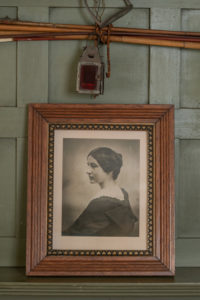
At first, the placement of a mirror in the corner of Sarah’s bedroom seems puzzling; its height and angle seem to serve no obvious function.
A closer look reveals Sarah’s purpose: the mirror reflects the portrait of Annie Fields on the mantel. A mirror atop a chest of drawers in the room also reflects the portrait.
Standing from any angle in the room, Jewett could see her beloved Annie.
Dear darling Fuffs –
This little note came from dear [Celia Thaxter] this morning and I will send it right to you – Do tell me what she says – I am going over to Exeter this afternoon to see my grandfather and perhaps stay until evening – not overnight – Poor little Fuff being lonely at Nahant! – but it shall be ever so long before you shall be alone again…Kiss dear Rogery on the top of his smooth head for me – and Kiss Miss Fuffy Fields in the looking glass and play it was Pin! Day after tomorrow I shall have you!!
MS Am 1743 (157), Houghton Library, Harvard University. Transcription by Terry Heller, Coe College.
Eastern Brook Trout
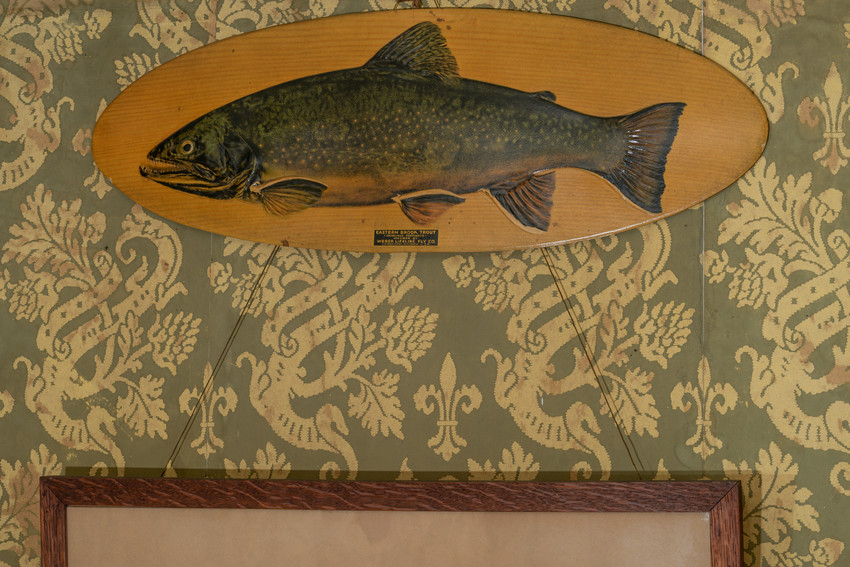
Something of a curiosity, this plaque was made by a fly-fishing supply company as an advertisement. It would have been displayed in a store to promote fly-fishing products. It was made not long after 1900, so it would not have been an antique when Sarah obtained it.
That Sarah included the trout plaque in her bedroom collection speaks to her connection to the outdoors. It also speaks to the androgynous quality of the space; the room is neither expressly feminine nor masculine.
Back Stairs
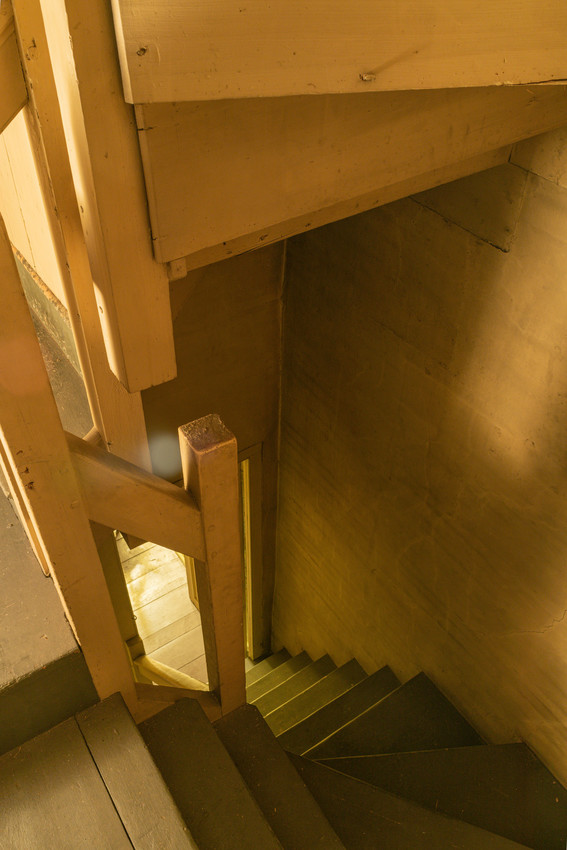
Back stairs were commonplace in eighteenth-century built houses. Their purpose was to allow household servants to execute their work while keeping them out of sight as much as possible. Back stairs in these houses are usually narrow and dimly lit.
This set of stairs leads from the attic down directly to a landing between Sarah’s room and the guest room on the second floor and down to the breakfast room, which is located next to the kitchen, on the first floor.
After an accident in 1902, Sarah’s health declined, and she was occasionally bedridden. This was particularly so in the spring of 1909, during her final few months. Domestic staff Katy and Mary Galvin may have used these stairs to bring her food, medicine, other necessities during this time.
Creating the Space

As seen in this modern floor plan, Sarah’s room would originally have been as large as the other three family chambers on the second floor.
To provide rooms for domestic staff, Sarah and Mary Rice Jewett added a second story to the first-floor kitchen ell. Previously, domestic staff quarters had been housed in the attic.
A hallway was needed provide staff access to the family rooms. For this hallway, they took space from the chamber that would be Sarah’s, reducing that room’s size.
It is interesting that Sarah chose this smaller back room for her own. It may have been that this public person, who had always needed time alone, preferred the private feeling of the room. Its northern exposure lends a peaceful quality to the space and may have appealed to “poor, tired Pin,” as she wrote of herself to Annie more than once.
The washrooms shown in the floor plan were later additions, though the house did acquire indoor plumbing in Sarah’s lifetime.
